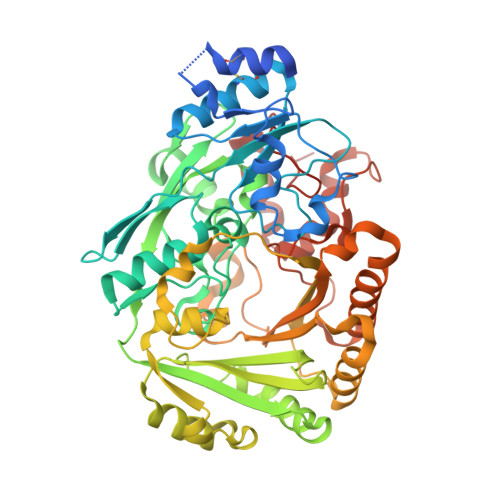Structure of a Berberine Bridge Enzyme-Like Enzyme with an Active Site Specific to the Plant Family Brassicaceae.
Daniel, B., Wallner, S., Steiner, B., Oberdorfer, G., Kumar, P., van der Graaff, E., Roitsch, T., Sensen, C.W., Gruber, K., Macheroux, P.(2016) PLoS One 11: e0156892-e0156892
- PubMed: 27276217
- DOI: https://doi.org/10.1371/journal.pone.0156892
- Primary Citation of Related Structures:
5D79 - PubMed Abstract:
Berberine bridge enzyme-like (BBE-like) proteins form a multigene family (pfam 08031), which is present in plants, fungi and bacteria. They adopt the vanillyl alcohol-oxidase fold and predominantly show bi-covalent tethering of the FAD cofactor to a cysteine and histidine residue, respectively. The Arabidopsis thaliana genome was recently shown to contain genes coding for 28 BBE-like proteins, while featuring four distinct active site compositions. We determined the structure of a member of the AtBBE-like protein family (termed AtBBE-like 28), which has an active site composition that has not been structurally and biochemically characterized thus far. The most salient and distinguishing features of the active site found in AtBBE-like 28 are a mono-covalent linkage of a histidine to the 8α-position of the flavin-isoalloxazine ring and the lack of a second covalent linkage to the 6-position, owing to the replacement of a cysteine with a histidine. In addition, the structure reveals the interaction of a glutamic acid (Glu426) with an aspartic acid (Asp369) at the active site, which appear to share a proton. This arrangement leads to the delocalization of a negative charge at the active site that may be exploited for catalysis. The structure also indicates a shift of the position of the isoalloxazine ring in comparison to other members of the BBE-like family. The dioxygen surrogate chloride was found near the C(4a) position of the isoalloxazine ring in the oxygen pocket, pointing to a rapid reoxidation of reduced enzyme by dioxygen. A T-DNA insertional mutant line for AtBBE-like 28 results in a phenotype, that is characterized by reduced biomass and lower salt stress tolerance. Multiple sequence analysis showed that the active site composition found in AtBBE-like 28 is only present in the Brassicaceae, suggesting that it plays a specific role in the metabolism of this plant family.
- Institute of Biochemistry, Graz University of Technology, Graz, Austria.
Organizational Affiliation:



















